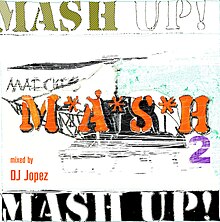Mashup (culture)
Artists such as Marcel Duchamp were the first to introduce already existing objects, which they rearranged and combined in collages, to the world of higher art.
Especially for younger people, this new gained freedom when it came to the accessibility of audio files lead to the development of a new form of cult around the transformation of musical pieces.
In 2002, a Newsweek article described the mashup of songs as a strategy of Londoner DJs to transform music they considered bad into something they could appreciate and were willing to listen to.
"In some cases, the illegality of piracy contributes to the appeal of unauthorized copies online" states Shiga in her article Copy-and-Persist: The Logic of Mash-Up Culture.
Even though copyright laws were intentionally supposed to stop illegal downloads, they contributed to the appeal of mashup and to the culture existing around it.
Consumers are turning into producers as well, especially due to the simplification of online tools that help creating personalized content.
The audience is taking on a DIY spirit, each masher becoming a mini-Burroughs, cutting the music and pasting it on a blank sheet of MP3Paul D. Miller, also known as DJ Spooky, Sound Unbound: Sampling Digital Music and Culture, a book about mashup culture's influence on society.
